Hello there! 🙂
I am back with a new, simple recipe for a shampoo without SLES (sodium laureth sulfate).
Just to make it clear: I am NOT against SLES in general (HERE you find a recipe of a SLES shampoo I posted a while ago). I still believe that the best shampoos include SLES (these shampoos have the best wetting ability, the best spreading ability, they feel great, they wash great: overall they give a satisfactory experience)… However this ingredient is not suitable for everyone, here the reasons why:
1) sometimes, specially if used constantly, it can irritate the scalp and it can make it itchy. Obviously if this happens, it is a good idea to stop using shampoos which contain SLES, at least for some time.
2) for people with thin hair it is not a great idea to use a shampoo with a strong Anionic Surfactant (like SLES) in the first position of the ingredients list. It has been shown through studies that Anionic Surfactants actually weaken the hair and the skin of the scalp (because this is, to make it very simple, the way they “clean”).
However please don’t read it like “omg I will stop using SLES all my entire life”: if it can make you feel any worse ANYTIME you wash your hair (even if you were washing them just with water) you are actually damaging them 😉 so chill: you have been “damaging” your hair all your life, and they are probably still there! 😀 (and PS I suggest you to keep damaging your hair by washing them 😉 ).
3) it is not an eco-friendly ingredient, therefore people who want to use ONLY eco-friendly ingredients should avoid SLES (as many other ingredients as well).
[Just to make it clear: there are no real studies about the hazardousness of SLES for health. This is why I didn’t include these rumors in the reason why one should avoid the ingredient. 😉 Not everything you find on the internet is true: most of the bad rumors about SLES were invented in order to scare people and make them buy (unreasonably) expensive shampoos that wouldn’t contain it].
This said 🙂 now a few words about this recipe!
I have made a Glucosides-based shampoo.
I admit that the first time I used it, it was not a great experience: I have very long hair and the detangling effect of this shampoo compared to my favorite SLES shampoo was just… not enough! However: my scalp stopped itching from the very first use, and this was a great feeling! 🙂 I learnt to love this shampoo eventually, so this is why I am posting this recipe today (I have finished one Kg of it! So I can say it is a tested recipe) 🙂
This recipe makes for a quite liquid shampoo, which is usually not something I would appreciate; however, it seems functional to the recipe in the way that if it was more thick, it would be more difficult to spread (so if you try this recipe, try it first as it is! If then you want to change something, you can add a gelling/thickening agent to the water phase if you like).
To make it more conditioning I added “Polyquaternium 7”, which you could omit if you have short hair.
[In case you are new to my blog, you find all the explanation on how to make REAL cosmetics at home HERE, together with a list of all the other recipes I posted.
If you, instead, know the theory but feel overwhelmed by the ingredients I am using, I have made a post which reports the links of some of the online cosmetic ingredients shop I know of, you find it HERE. 🙂 Everything can be done, if you want it enough 😉 ]
RECIPE:
Phase A
Water to 100 (meaning HERE)
Glycerin 2
Epsom Salts 1 (this ingredient helps in giving volume to the hair, if you don’t need volume, omit it)
Hydrolized Keratin Powder 0.4 (if you have the liquid form, add up to 5%)
Phase B
Lauryl Glucoside 10
Decyl Glucoside 6
Coco Glucoside & Gliceryl Oleate 3 (if you have a greasy scalp, lower this ingredient at 1%)
Fragrance (oil based) 0.5
Phase C
Cocamidopropyl Betaine 10
Preservative (you add it at the specific percentage requested by your preservative)
Polyquaternium 7 – 1
Citric Acid to adjust the pH IF NEEDED.
Now to the HOW TO:
1) Pour the Epsom salts in the Glycerin
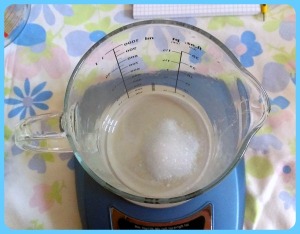
2) Add the water and the proteins
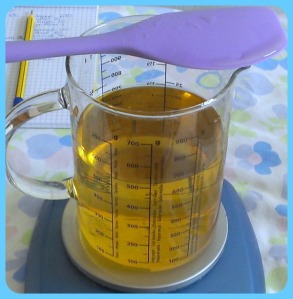
(notice the color is given by the proteins)
3) Now measure the Phase B in a separate becher
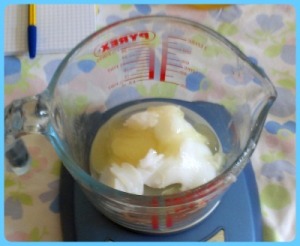
4) Heat it up a little in order to melt the Lauryl Glucoside (the white stuff)
This will be the result
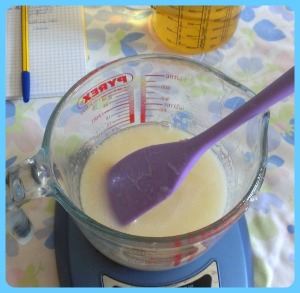
5) Now mix the two phases together
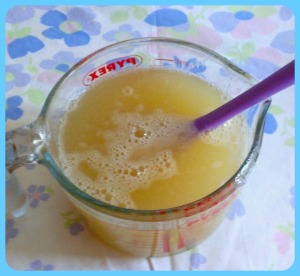
6) Measure separately the betaine and pour it in the mixture

7) Do the same for the Polyquaternium 7 and the preservative. Adding them one at a time and mixing carefully after you add them.
8) Check the pH and adjust to pH5 if needed.
🙂 That’s all 🙂 Extremely fast!
For more recipes click HERE
To learn how to formulate cosmetics click HERE
For a list of online cosmetic ingredients suppliers click HERE
Lately I have received from a reader of the forum the INCI of a shampoo with SLES but that seems to be extremely mild 🙂 I think I will start experimenting on that as well 🙂
Did you like this recipe? 🙂
Any request? 🙂
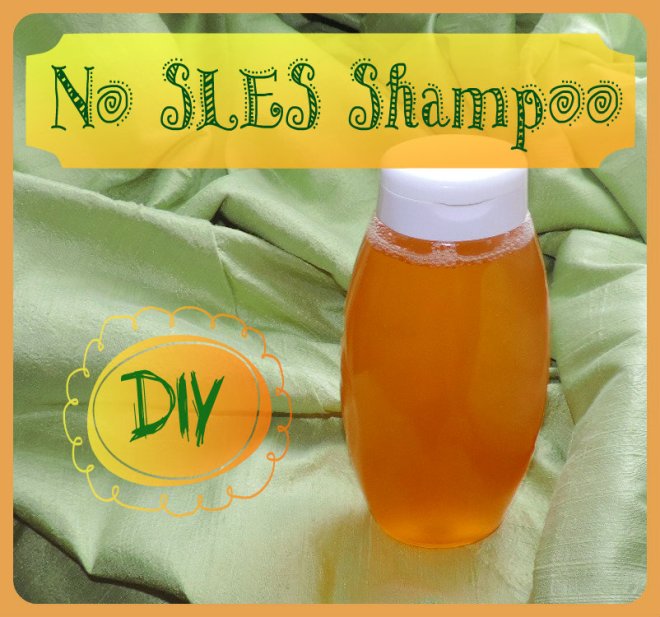

Aahh. . I see. . Well hi! I think im gonna omit the cetrimonium chloride. . Im also searching for other thickener and just found Hydroxyl Ethyl Cellulose. I bet you must know this. . It is non ionic charge, i think i would change with the guar gum since the texture of my shampoo actually clumpy. . Do you think it still gonna be okay? Since it is non ionic. . Actually im still trying to understand about the ionic things😣 i look at other people using Hydroxyl Ethyl Cellulose turn out the texture look nice.
LikeLike
Hmmm it is not my favourite but it is a solution. You could also thicken using other surfactants that get thick together. A very foamy and good at thickening surf I am liking lately is sodium methyl cocoyl taurate (the salt in it helps thicken other surfactants and it is in paste form, which helps too).
LikeLike
Awww thank you! I ll try to check if i.can find it on my country .
LikeLiked by 1 person
Why so many glucosides mam.. Is it okay to have just one of them
LikeLike
Cause at the time this formula was made glucosides were the “best” ecocert approved.
Now there are better surfactants for the hair that are ecocert approved.
You CAN use a single glucoside, but I don’t really think it will make for a good shampoo.
LikeLike
Hi, love your blog, just found it!
What do you think of this surfactant system below? And how would I make it even more mild?
Coco Glucoside 5%
Decyl Glucoside 5%
SCI 1%
Glycerol Oleate 0.5%
I’m allergic to CAPB/CAP Hydroxysultaine so I’m leaving out those amphoterics.
LikeLike
Well it all depends what you want to obtain, but with surfactants more or less any combination could work, it all depends if it works for the product you are trying to achieve 😉
LikeLike